Archive for Places to go
January 23, 2006 at 5:30 am · Filed under Places to go
Looking on a map you might wonder about the remoteness of this park we’re in. We are 85 miles from Gila Bend, which is itself a dot on the interstate highway in the midst of a lot of desert. Is there anything to do here, anything to see that we haven’t seen in other desert parks (Death Valley, Joshua Tree, Anza-Borrego, Big Bend)?
The answer is of course “yes.” I am constantly amazed at the diversity of deserts. This place is nothing like Anza-Borrego (which was nearer the Mojave desert). Here we are in the Sonoran desert, the only place where the iconic Saguaro cactus grows ““ the one with the big arms that every associates with American deserts. In fact, there are forests of Saguaro here, along with the Organ Pipe cactus that the park is named for, and other creatures that live only in this one place.
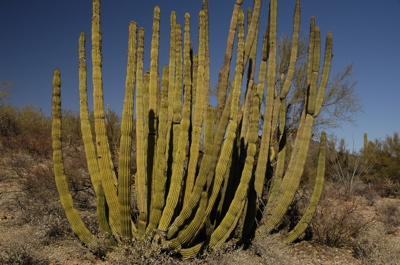
Probably the most famous is the Quitobaquito Desert Pupfish, which lives only in one place in the world, Quitobaquito Pond, a little spring just a few miles from here. Talk about endangered. This lively little fish has to survive in a little wet spot in the middle of a big desert, and if the pond has a drought, or if somebody introduces an invasive plant or animal, or if pollution gets too bad ““ they’re gone. The Desert Pupfish is a symbol of endangered creatures everywhere.
The Tohono O’odham Native Americans are another unique feature of this area. They have been here for centuries, and they still maintain many of their traditional practices, foods, and crafts. I am looking forward to driving through their nation on Rt 86 tomorrow. I’d like to try some of their prickly pear preserves, among other things!
In many of the desert parks you can find excellent viewing of the night sky. The stars in Anza Borrego were great, but here they are absolutely stupendous. Last night was crystal clear and the only light pollution was from Sonoyta, six miles away in Mexico. The stars were breathtaking just with the naked eye. (Too bad the temperature plunged from mid-70s to about 45 just a couple of hours after sunset!)
And finally, there’s the educational aspect of desert National Parks. No matter how many we go to, we always learn and appreciate more about the desert and the living things that have inhabited it, whether people, animals, or plants. This morning, we learned quite a bit from a simple 1.2 mile hike.
The nature of our border problems has changed some of this park. For example, roads are closed in some places. This meant we couldn’t go see Quitobaquito Pond. (But there is a small pond near the Visitor’s Center which contains a transplanted community of pupfish.)
Hiking around, we spotted a pair of large blue flags hanging off a pole. These are markers for “humanitarian stations” for undocumented aliens ““ e.g., emergency water for border crossers. Park staff and border patrol call them “UDAs”. Too often they show up to find a new life in America, abandoned in the desert and not carrying nearly enough water or proper clothing for a 100 mile hike through lands that routinely reach 110 degrees in the summer. At other stations, the UDAs can avail themselves of solar-powered call boxes to call for help.
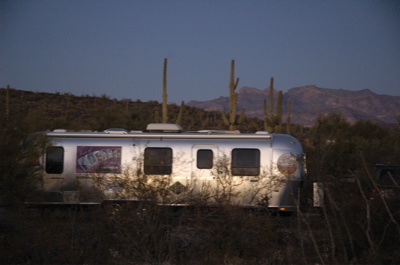
At night in the winter, the temperatures can be equally challenging. I guess we were spoiled by the mildness of Borrego Springs. Here, the wind comes up around 7 pm and the temperature plummets. We were forced to dig out all the warm clothing we have for the evening amphitheater program. We sat through “Intern Dan’s” talk while wearing two shirts, fleece, jacket, hat and gloves, and sitting on a towel to insulate against the cold benches. The rest of the audience was similarly dressed ““ we looked like a winter skating party.
Intern Dan gave us a fine presentation on the sounds of the desert animals. He’d play a sound and then have us guess which one it was. We were able to identify almost all of them (except the T-Rex he threw in as a curveball): great horned owl, coyote, mountain lion, Anna’s Hummingbird, javelina, even the silence of the jackrabbit. Emma, sitting in the front row, thought it was great fun.
The batteries are dead again. I ran the generator for 3.5 hours yesterday, and the batteries were mostly re-charged, but the burden of the furnace running frequently this cold night has been too much. I’m sitting here at 5:30 a.m. and I can hear from the whine of the furnace motor that we are out of power. The battery status light on the monitor panel is blinking red. We won’t be able to run the water pump this morning. Very frustrating.
We are leaving today, so I suppose I can take a shower after we are hitched up (with the truck running to supply power), but I can see we are going to have to come up with a better solution for boondocking nights in the cold desert.
December 30, 2005 at 6:08 pm · Filed under Places to go
This morning we hitched up and moved out! We pulled the Airstream up to 4000 ft elevation on I-8, crossing the rocky summits and winding down slowly to the desert floor on the eastern side. It was a marvelous scenic trip through a very quiet corner of California. Halfway along I-8, we pulled off onto an abandoned road somewhere near the border of San Diego and Imperial counties and took in the view while we had lunch.
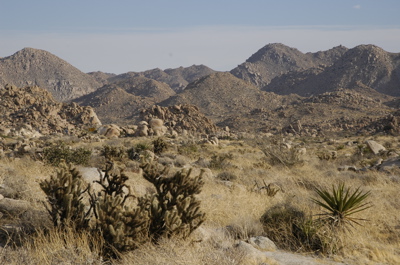
View from our lunch stop.
Because I was having equalization problems due to the aftereffects of the cold, we took a massive detour which allowed us to descend more slowly. It also doubled the length of our trip, and bypassed the historic town of Julian. We’ll stop in Julian on the way back, instead.
This spot rocks! Borrego Springs is a small town in the middle of a very big desert state park: Anza-Borrego State Park. We’re camped in one of the two state park campgrounds, just west of town at the foot of the mountain range. Full hookups, five bars on the mobile phones, good Internet service, endless sunshine and 70 degrees every day!
Plus, the heavy rains of last summer have yielded a bonus: desert flowers out of season. We’ve already spotted a few.
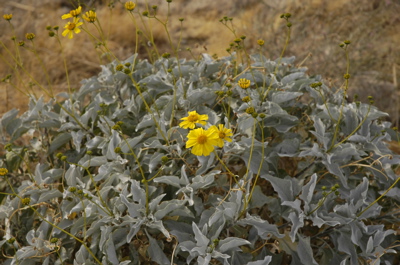
There’s lots to do. This is high season for the park, so there are three ranger talks each day, nightly campfire programs at 7:30, and Anza Borrego is famous for great hiking, bighorn sheep, and off-roading. Even the campground is fun: everyone has colorful lights on their awnings and glorious wood campfires on the sand (in fire rings), probably getting in the mood for New Year’s Eve. I think we’re going to like it here. Tomorrow, we have some hikes planned. I’ll start posting pictures tomorrow night.
December 29, 2005 at 7:54 pm · Filed under Places to go
I am pleased to report that Operation Kill Paper has been a success already, although it is not complete. I’ve reduced my paper to about half of what it was, and we celebrated with a paper bonfire at sunset. If we’d had some wood handy I would have gotten a proper fire going — the evening temperatures are perfect for it.
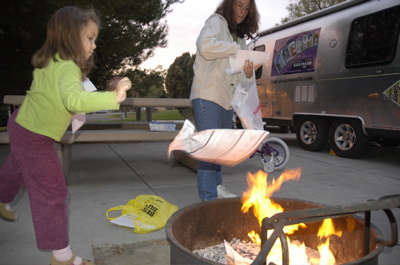
One of the very best places in San Diego is Balboa Park. A beautiful and architecturally interesting place, it is both a series of green parklands and world-class collection of museums.
On Saturday we visited the Museum of Natural History, on Christmas we went there for the San Diego Zoo, on Tuesday (while I was stuck at home with a cold) Eleanor & Emma went to the Aerospace Museum, and today we returned to go the Reuben Fleet Science Center. Among other things, Emma got to learn about tornadoes.
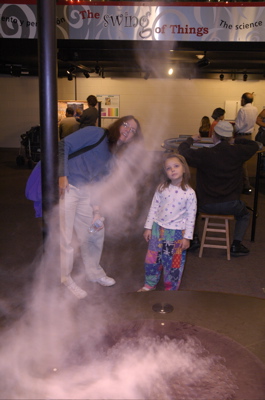
Just a walk around Balboa Park is worth the trip, even if you never enter a building. Most of the building designs are based on Spanish Colonial Architecture, dripping with terra-cotta oraments and sculpted details. I wish I’d taken some photos for you but my head was just not fully together today. (The cold lingers on.)
The question now is whether we’ll depart tomorrow for Borrego Springs or hang around San Diego another day. We’ll decide tomorrow.
December 25, 2005 at 5:48 pm · Filed under Places to go
We’ve had a very nice Christmas (for the second time this year!)
Last night Eleanor made the Christmas eve dinner I talked about the other day. I grilled the steak outside since the weather was fairly warm (about 58-60 last night), and Emma and I played a little “flashlight tag” in the dark, while Eleanor prepped the rest of the meal. The steak came out perfectly. We met up inside around 7 pm and had a fabulous meal. The plantains were included mostly because Emma saw them in the grocery store and was wondering what they were. They were delicious, pressed, fried, and seasoned.
After dinner we watched “Dr Doolittle 2”, put all the Christmas presents under the “tree” (our rosemary bush), left out cookies and carrot sticks for Santa and the reindeer, and cajoled Emma into bed. Santa arrived later with a few additional presents.
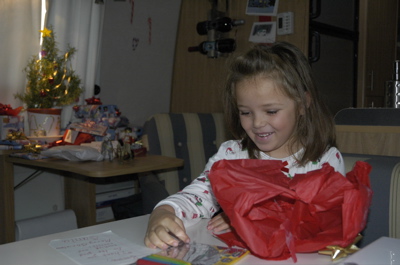
It is perhaps the oddest Christmas we have ever spent. 3000 miles from home, in a warm climate, in an Airstream trailer, sitting atop a hill in the arid hills above San Diego, but it was also an excellent Christmas. The little things that make holidays great were all there: each other, good times and good food, calls from friends and family, and a feeling of well-being. So it didn’t feel odd, it felt fine.
Emma would like you to know that she got everything she asked for: a unicorn, a tin whistle, and a seahorse. She also got a few other goodies. Mommy & Daddy got some books, edible treats, and DVDs.
But mostly what we got was a nice day. It turned out that the San Diego Zoo is open on Christmas, so after pancakes we spent a very nice day among the birds and animals. If you have never been to the San Diego Zoo, let me recommend it. I am not a big fan of zoos, but this one is a day well spent. I will have some pictures on the Flickr photo album later tonight.

We’re back now, and worn out, so we have decided to eat leftovers from last night and save the pork roast for tomorrow. No need to push it — we’ll just let the holiday go an extra day!
December 19, 2005 at 5:38 pm · Filed under Places to go
Well, our luck has changed. Not only has the weather improved (upper 60s and partly cloudy), but we stopped in at a state beach and found a really nice spot to camp just south of Santa Barbara.
To be honest, it wasn’t all luck. We picked up a copy of the California state park brochure called the “Guide to Reserving State Park Campsites” several weeks ago, and it has become our cheat sheet ever since. We knew that Carpinteria would offer us hookups. After three nights of dry camping we felt like not having to worry about using the lights and water as much.
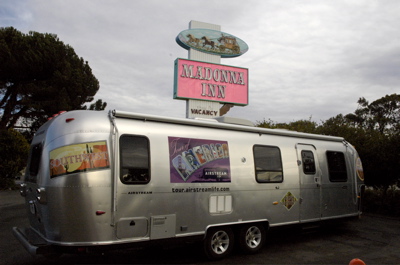
On the way, we stopped at the famous Madonna Inn. The last time I was here was in 1979. I am pleased to report that the Men’s room has not changed significantly. The waterfall urinal is still there. Those of you who have visited the Men’s room at the Madonna Inn will know what I mean.
We also made a shopping stop, for Christmas stuff. Although we had Christmas in Vermont, we have advised Emma that Santa will visit us no matter where we are. Eleanor wants to get the trailer ready, so we bought a little potted rosemary plant, which looks remarkably like a small fir tree. This will get decorated with tiny ornaments, and after Christmas it will probably be eaten! Eleanor is hanging cards and stockings in the trailer as I type this, and Emma is making paper decorations. Everything is lightweight, small, and either recyclable or edible — perfect for mobile life.
Our campsite at Carpinteria is right next to the beach, with full hookups. We are literally forty feet from the sand, and can hear the waves crashing and the beach stones tumbling with every wave. The evening is balmy, many of our neighbors have festive lights up, and there’s even an Airstream Classic motorhome (a 290) parked just a few spaces away. (I’ll go see them in the morning.)
We arrived so close to sunset that I pushed Eleanor and Emma out of the truck as soon as we pulled in, and said, “Go to the beach! Now!”, which they did happily. They caught about 20 minutes of fun collecting shells and splashing in the surf before it got too dark to see. I ran over to join them as soon as I had the truck unhitched, but of course that meant I had to set up the utilities in the dark. Not a big price to pay.
We’ll definitely stay a couple of nights here at least. Our thought is to try another state beach campsite in Huntington Beach and stay there through Christmas. If anyone has experience with that campground, let us know how it is.
December 17, 2005 at 6:23 pm · Filed under Places to go
We’ve been driving coastal Route 1 south from Santa Cruz and it just keeps getting better. I have tons of pictures but for now I’ll just post a few and try to get a new photo album up in the next few days.
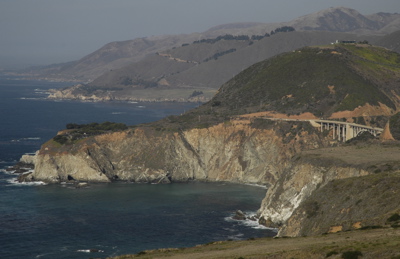
Our progress has been deliberately slow. Route 1 is a road to be savored. There are pullouts every mile or so, and nearly every one offers spectacular views to the Pacific Ocean on one side, and the hills rising on the other.
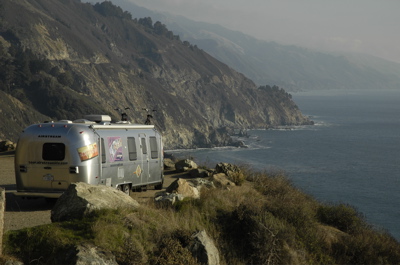
Somewhere south of Big Sur we pulled over and spotted a flock of six condors hovering in the breeze. These enormous birds were nearly extinct at one time, but they are recovering. What an impressive sight to see a condor, with a wingspan bigger than you are, swooping right over your head!
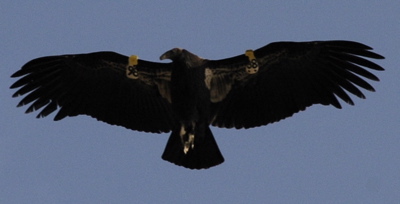
Last night we camped at the Kirk Creek National Forest Service campground, which is part of the Los Padres National Forest. (No hookups, questionable water, $20 per night.) This spectacular campground sits atop a bluff overlooking the ocean, and there are wonderful trails down to the sea. From our campsite we could hear the thudding of huge waves breaking on the rocks. I wish it had been warm enough to sleep with the windows open.
Hunting for interesting rocks near our campsite, Eleanor and Emma discovered opal. Yes, opal. We are not sure yet if it occurs naturally in this area or if someone simply left bits of a larger one there, but we found about 1/4 lb of it in small fragments, ranging in color from nearly white to black-blue. We have saved the bits and plan to mail a few to Emma’s grandparents for polishing.
This morning, the day became overcast (but still 60 degrees), and the wind picked up. We made fewer stops along the coast but when we spotted elephant seals on the beach, we had to take a look.
It turns out that there’s a stretch of coastline just north of San Simeon where another endangered creature, the elephant seal, has been visiting annually for the past 12 years. They come to mate and give birth, all the way from their summer home in the Aleutian Islands. “Friends of the Elephant Seal”, a local group, act as docents and were standing nearby in blue jackets to help educate us about these fascinating animals.
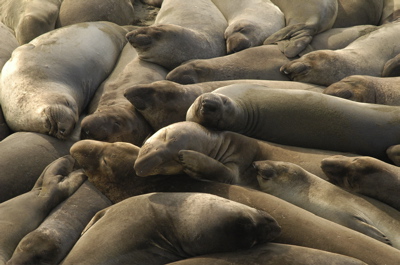
The seals get up to 5,000 lbs. The beach was mostly filled with young males, who arrive a few weeks before the big guys arrive. When the big males show up, they battle for bits of the beach (mostly by bellowing) and then gather a harem of 30-40 already-pregnant females. The females give live birth on the beach, nurse the pup for 28 days, and then they are free to mate with the male. If the pup has gained enough weight (200 lbs!) it will teach itself how to swim and fish. Otherwise, tough luck.
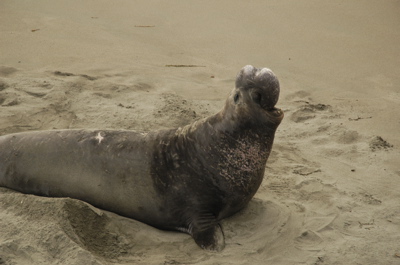
An elephant seal can swim to 5,000 feet below the sea! It has super-oxygenated blood (and a lot of it) and some other tricks to allow it to avoid breathing for hours. We learned all this and more in a 30 minute visit, while the elephant seals snoozed and bellowed on the sand just a few feet away.
The rest of the day was spent running errands in the cute little town of Cambria, CA, just a couple of miles south of Hearst Castle. We needed everything: post office, ATM, propane, gas, water, dump station, and groceries. By the time we finished all that, the sun was setting and it was time to get back to our campsite at San Simeon State Park. We’ll spend tomorrow at Hearst Castle and then head further south on Monday.
December 4, 2005 at 8:08 am · Filed under Places to go
What a strange feeling, driving down the highway without an Airstream behind us!
We got that fantastic California feeling, zipping down 101 through the desert valley south of Gilroy. Couldn’t be a more beautiful day. Sunshine pouring down on perfect rows of garlic, strawberries, artichokes, cabbage, and many other fruits & vegetables. Farm stands, too. I think I spent the whole time hungry, thinking about all the food growing around us.
The funny thing is that Californians think Hwy 101 and I-5 are boring. They haven’t driven through the Utah salt flats along US50, I guess. I always find the desert drives to be colorful and endlessly fascinating, especially as the sun approaches the horizon and lights up all the land’s contours to the east.
We stopped off in Soledad CA to visit Pinnacles National Monument. It’s one of those out-of-the-way national parks that we wouldn’t have had a chance to see otherwise. No camping in the park, and it wasn’t on our planned route down the coast. But it turned out to be well-worth the small detour.
Pinnacles is an unusual park in that you can access it from the east or west side but there are no roads that go through. Rt 101 gives access from the east, via a winding, scenic little road called California 146. This road becomes a single lane for several miles before you finally arrive at the tiny Chapparall ranger station.
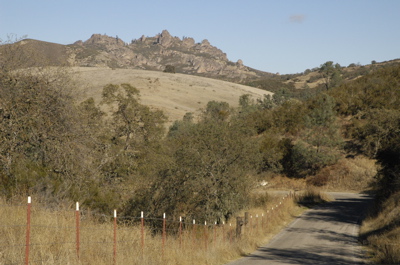
There are no services here. No Visitor Center on the east side. But plenty of great hiking, rock climbing “¦ and talus caves. The caves were our main reason for stopping ““ some bats were reportedly in resident in it, and we wanted Emma to get a chance to see some bats in the wild.
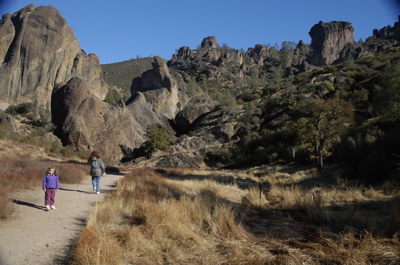
The sharp-looking rocks that form the Pinnacles are the remains of an ancient volcano. They lie directly on the San Andreas Fault, that famous border between the North American plate and the Pacific plate. The endless grinding of the two plates has put half of the old volcano’s magma flow here in Soledad. The other half lies 195 miles southeast.
If you are more tourist than geologist, the Pinnacles are a great backdrop for photography, a challenging place to climb rocks, and a beautiful place to hike. We had only a couple of hours, so we took a relatively short hike of 2.5 miles (100 ft elevation gain, not much) which brought us up to the talus caves and back.

Emma loved spelunking in the cave, as long as we were close by. There’s a bit of climbing involved, which is always popular with five-year olds. In the dark, negotiating rocks with a flashlight in one hand and an expensive camera around my neck, and an even more expensive child grabbing on me for support, I felt plenty challenged at times.
Unfortunately the bats were mostly out. We spotted only four smallish ones, snoozing on the wall. Still, it was a wonderful hike. Chestnuts had fallen from trees all through the area, with an amber hue that is completely different from the dark-brown chestnuts we have seen in the east. The Ponderosa pines left gigantic pine cones too, and the trail was constantly changing from dizzying cliffs to grassy floor, from dry wash to moist verdant moss. The hike was over in no time, and it was time to get back on the highway to Bakersfield.
Coming east from Hwy 101 the land turned to other western symbols: the wineries of the Paso Robles area, then oil wells slowly dipping up and down, strange-smelling processing plants, and palm trees. California is so big it should be three states, and so exciting and gorgeous it has the thrill of half a dozen others. I’m glad we’ll be back in ten days.
« Previous entries ·
Next entries »


















